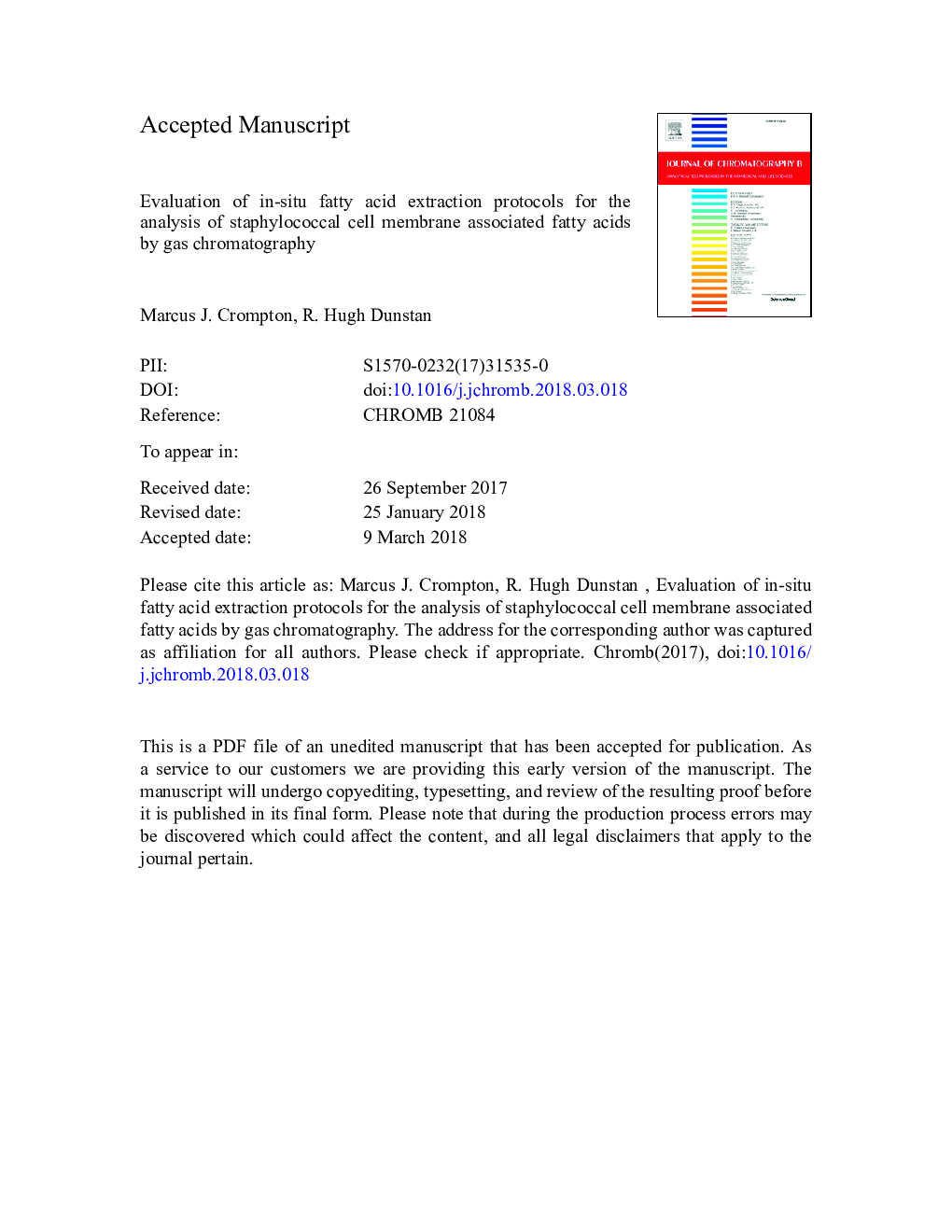| کد مقاله | کد نشریه | سال انتشار | مقاله انگلیسی | نسخه تمام متن |
|---|---|---|---|---|
| 7615138 | 1493985 | 2018 | 33 صفحه PDF | دانلود رایگان |
عنوان انگلیسی مقاله ISI
Evaluation of in-situ fatty acid extraction protocols for the analysis of staphylococcal cell membrane associated fatty acids by gas chromatography
ترجمه فارسی عنوان
بررسی پروتکل های استخراج اسید چرب در محل برای تجزیه و تحلیل اسید های چرب غشاء سلول استافیلوکوک توسط کروماتوگرافی گاز
دانلود مقاله + سفارش ترجمه
دانلود مقاله ISI انگلیسی
رایگان برای ایرانیان
کلمات کلیدی
SFAMIDIBCFAUFAMUFALCFAMCFAVLCFAsaturated fatty acid - اسید چرب اشباع شدهVery long chain fatty acid - اسید چرب زنجیره ای بسیار طولانیlong chain fatty acid - اسید چرب زنجیره طولانیPolyunsaturated fatty acid - اسید چرب غیر اشباعmonounsaturated fatty acid - اسید چرب غیر اشباعunsaturated fatty acid - اسید چرب غیر اشباعmedium chain fatty acid - اسید چرب متوسطPUFA - اسید چرب چند غیراشباعDirect transesterification - ترشح مستقیم مستقیم
موضوعات مرتبط
مهندسی و علوم پایه
شیمی
شیمی آنالیزی یا شیمی تجزیه
چکیده انگلیسی
The composition and integrity of the bacterial cytoplasmic membrane is critical to the survival of staphylococci in dynamic environments and it is important to investigate how the cell membrane responds to changes in the environmental conditions. The staphylococcal membrane differs from eukaryotic and many other bacterial cell membranes by having a high abundance of branch fatty acids and relatively few unsaturated fatty acids. The range of available methods for extraction and efficient analyses of staphylococcal fatty acids was initially appraised to identify the best potential procedures for appraisal. Staphylococcus aureus subsp. aureus Rosenbach (ATCC® 29213) was grown under optimal conditions to generate a cell biomass to compare the efficiencies of three approaches to extract and prepare methyl esters of the membrane fatty acids: (1) acidic direct transesterification of lipids, (2) modified basic direct transesterification of membrane lipids with adjusted reaction times and temperatures, and (3) base catalysed hydrolysis followed by acid catalysed esterification in two separate chemical reactions (MIDI process). All methods were able to extract fatty acids from the cell mass effectively where these lipids represented approximately 5% of the cellular dry mass. The acidic transesterification method had the least number of steps, the lowest coefficient of variation at 6.7% and good resistance to tolerating water. Basic transesterification was the least accurate method showing the highest coefficient of variation (26%). The MIDI method showed good recoveries, but had twice the number of steps and a coefficient of variation of 16%. It was also found that there was no need to use an anti-oxidant such as BHT for the protection of polyunsaturated fatty acids when the GC-MS injection liner was clean. It was concluded that the acidic transesterification procedures formed the most efficient and reproducible method for the analyses of staphylococcal membrane fatty acids.
ناشر
Database: Elsevier - ScienceDirect (ساینس دایرکت)
Journal: Journal of Chromatography B - Volume 1084, 1 May 2018, Pages 80-88
Journal: Journal of Chromatography B - Volume 1084, 1 May 2018, Pages 80-88
نویسندگان
Marcus J. Crompton, R. Hugh Dunstan,
